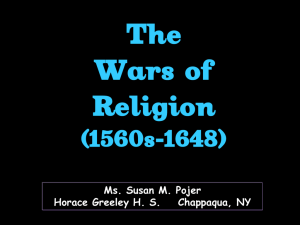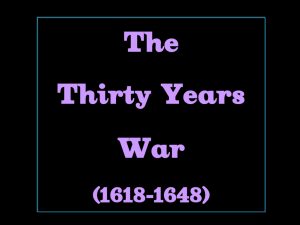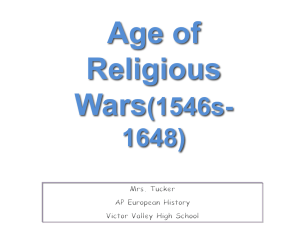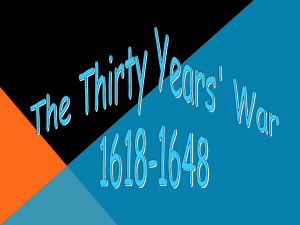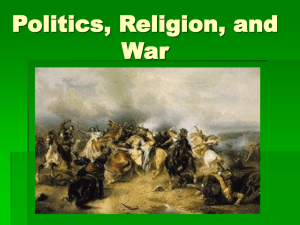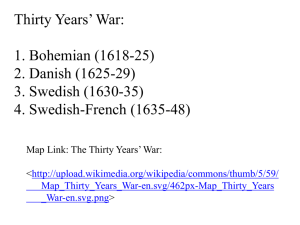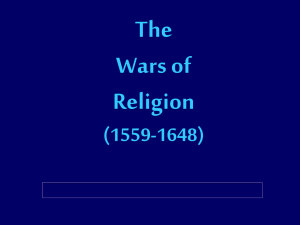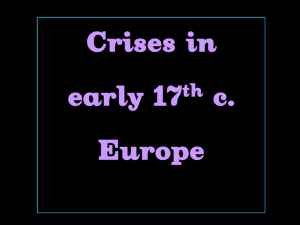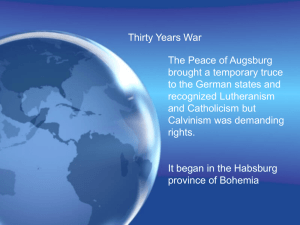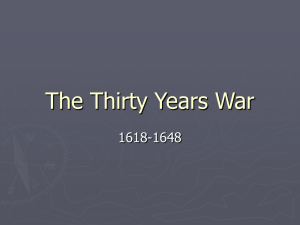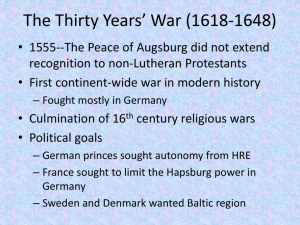The Wars of Religion
advertisement
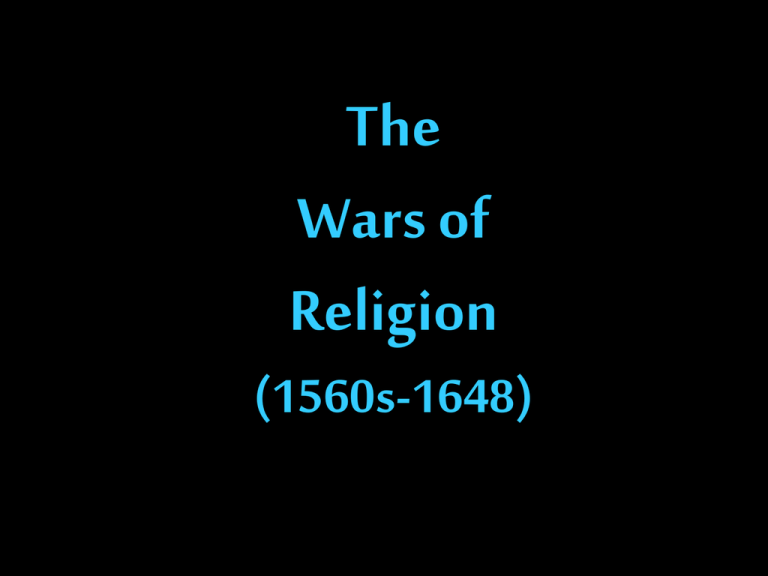
The Wars of Religion (1560s-1648) "Une foi, un loi, un roi," Civil War In France (1562-1598) Habsburg – Valois Wars • Treaty of Cateau-Cambresis – ended the wars (last purely dynastic wars of 16th c • Fr. Kept HRE from controlling ALL of ‘Germany’, while inadvertently helping Lutheranism to spread – major block • Spain def. Fr for control of Siciliy, Naples & Milan The Valois Family: The Beginning of the End Henri II was the last powerful Valois Three weak sons followed: Francis II Charles IX Henri III Catherine de Medici controlled the sons: Was mother to the boys Played both sides in the civil war Developed a reputation for cruelty Catherine de Medici Main Characters • The Valois Kings (Catholic) – Francis II (r. 1559-1560) – Charles IX (r. 1560-1574) – Henry III (r. 1574-1589) The French Civil War There were two sides: Guise family led Catholics in North Bourbon family led Huguenots in South Fighting for the royal inheritance Catherine supported the Guises in the first phase. St. Bartholomew’s Day Massacre August 24, 1572 20,000 Huguenots were killed Henri of Navarre, a Bourbon, survived St. Bartholomew’s Day Massacre The French Civil War Catherine started supporting the Bourbons. Catholic League CIVIL WAR Protestant Union Henri of Navarre defeated Catholic League & becomes Henry IV of France. Effects of Civil War: France was left divided by religion Royal power had weakened Valois family now replaced by Bourbons Triumphal Entry of Henry IV Into Paris – Peter Paul Reubens Henry IV of France Ended Spanish interference in France Converted to Catholicism : Did this to compromise and make peace Paris is worth a mass. This was an example of politique [the interest of the state comes first before any religious considerations] Fighting for the royal inheritance Passed Edict of Nantes in 1598: Granted religious rights to Huguenots Did not grant religious freedom for all The Thirty Years War (1618-1648) 1618-1648 Characteristics of the Thirty Years War The Holy Roman Empire was the battleground. At the beginning it was the Catholics vs. the Protestants. At the end it was Habsburg power that was threatened. Resolved by the Treaty of Westphalia in 1648. The Bohemian Phase: 1618-1622 Ferdinand II inherited Bohemia. The Bohemians hated him. Ferdinand refused to tolerate Protestants. Defenestration of Prague May, 1618 Bohemia named a new king, Frederick II. The Bohemian Phase: 1618-1622 Ferdinand II becomes Holy Roman Emperor. Frederick II borrowed an army from Bavaria. Frederick lost his lands in the fighting. The rebellion in Bohemia inspired others. Bohemian Phase The Danish Phase: 1625-1629 Ferdinand II tried to end all resistance. Tried to crush Protestant northern Holy Roman Empire. Ferdinand II used Albrecht von Wallenstein for the army. Wallenstein defeated Protestants in north. Edict of Restitution (1629): Restored to Catholics all lands lost since 1552. Deprived all Protestants, except Lutherans, of their religious and political rights. German princes feared Ferdinand he fired Wallenstein in effort to calm them. Danish Phase Albrecht von Wallenstein The Swedish Phase: 1630-1635 France & Sweden now get involved. Both want to stop Habsburg power. Sweden led the charge. France provided support. Gustavus Adolphus invaded the HR Empire. Ferdinand II brought back Wallenstein. Swedish advance was stopped. German princes still feared Ferdinand II. Wallenstein assassinated to appease them. Swedish Phase Gustavus Adolphus The French Phase: 1635-1648 France & Sweden switched roles. All countries in Europe now participated. This phase was most destructive! German towns decimated. Agriculture collapsed famine resulted. 8 million dead 1/3 of the population [from 21 million in 1618 to 13.5 million in 1648] Caused massive inflation. Trade was crippled throughout Europe. Loss of German Lives in 30 Years’ War The Peace of Westphalia (1648) Political Provisions: Each Ger. prince became free from any kind of control by the HR Emperor. The United Provinces [Dutch Neths.] became officially independent so. part remained a Sp. possession. Fr. rcvd. most of the Ger-speaking province of Alsace. Sweden got lands in No. Ger. on the Baltic & Black Sea coasts. Switzerland became totally independent of the HR Emperor Swiss Confederation. Sweden won a voice in the Diet of the HR Emp. Brandenburg got important terrs. on No. Sea & in central Germany. The Peace of Westphalia (1648) Religious Provisions: Calvinists would have the same privileges as the Lutherans had in the Peace of Augsburg. The ruler of each state could determine its official religion, BUT [except in the hereditary lands of the Habsburgs], he must permit freedom of private worship. Treaty of Westphalia (1648) 1688-1700 Nobody Was Happy! Many Protestants felt betrayed. The pope denounced it. Only merit it ended the fighting in a war that became intolerable! For the next few centuries, this war was blamed for everything that went wrong in Central Europe. What were the longrange effects of the Thirty Years’ War?
